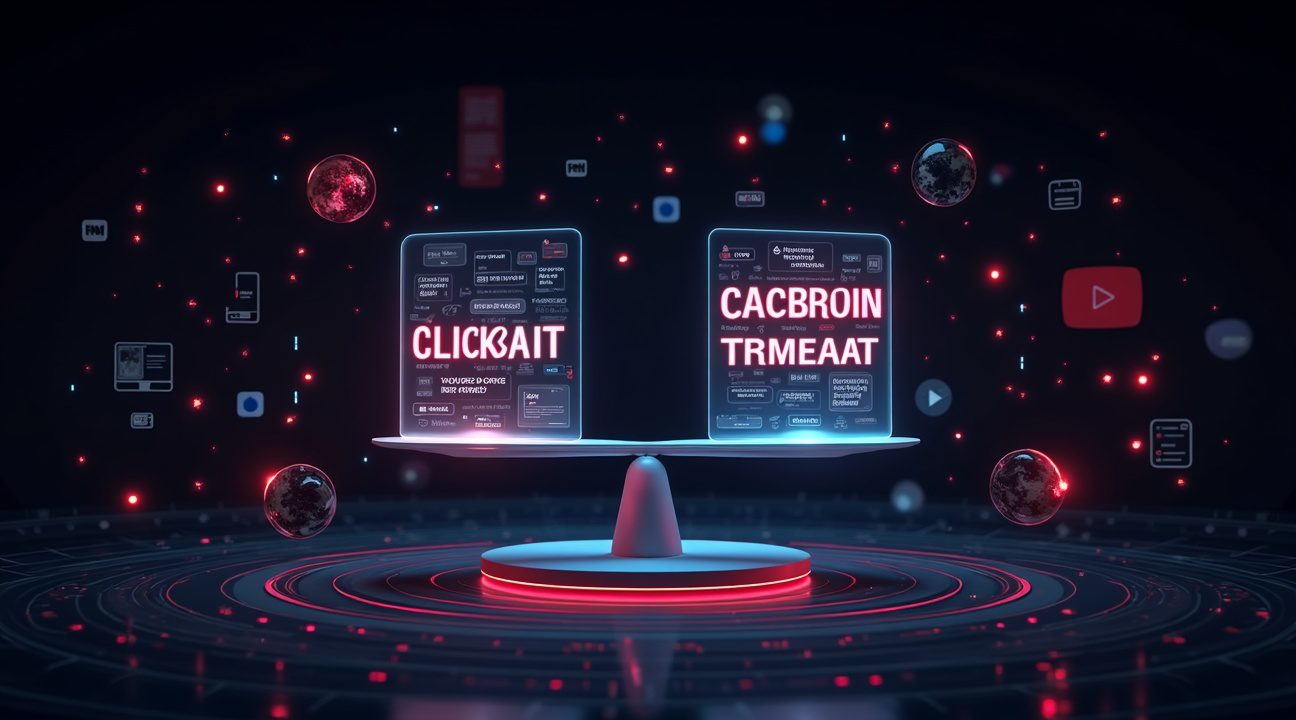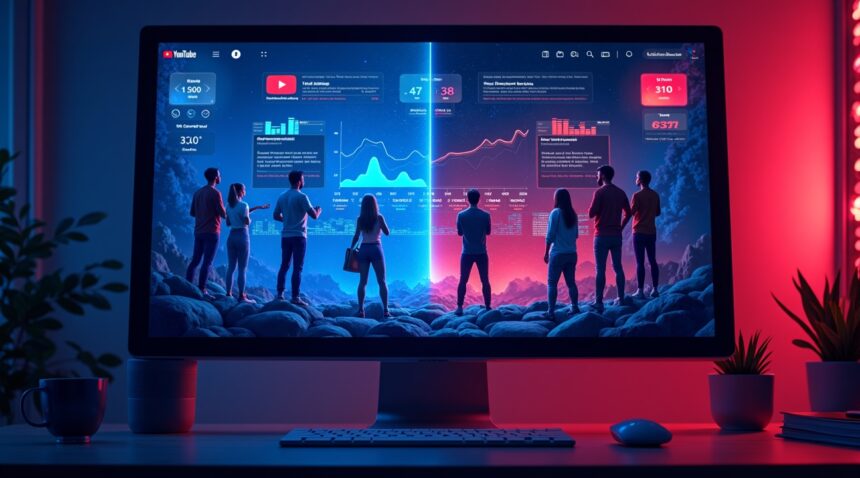YouTube has officially announced its controversial A/B Title Testing feature, branded as “Test & Compare for Titles,” which allows creators to simultaneously test up to three different titles for the same video while measuring engagement and click-through rates.
Key Takeaways
- The A/B Title Testing feature allows creators to test up to three different title variations simultaneously, with YouTube’s algorithm automatically distributing the titles to various audience segments to measure performance.
- The rollout begins in the United States during Q3 2025 with select creators and will expand to more users later in the year as part of a phased launch strategy.
- The feature has sparked debate in the creator community, with long-time supporters praising the data-backed optimization while others are concerned it might encourage clickbait or misleading headlines.
- YouTube’s testing tool integrates with the platform’s major 2025 algorithm overhaul, which will focus more heavily on user satisfaction and personalized engagement.
- YouTube has reaffirmed its commitment to current community guidelines and content accuracy, urging creators to prioritize clarity rather than sensationalism in titles.
How “Test & Compare for Titles” Works
The new feature enables YouTube creators to upload up to three different titles for a single video. YouTube’s algorithm then randomly assigns each title to different segments of the audience, collecting performance data based on:
- Click-through rates
- Total watch time
- Audience retention and overall engagement
Creators are provided with a detailed analytics breakdown, helping them identify the top-performing title variants across various viewer segments. According to early beta data, many creators experienced improvements in performance metrics such as a 15–30% increase in click-through rates when using optimized titles.
Concerns from the Community
Despite its analytical appeal, the tool has raised concerns in the YouTube creator community. Critics argue that this functionality might lead to an uptick in deceptive or exaggerated video titles. While optimized headlines may drive initial clicks, there’s concern it might reduce content integrity over time.
In response, YouTube has emphasized that all tested titles must adhere to existing platform rules. Misleading or deceptive language is still subject to enforcement under the Community Guidelines, and violations may result in penalties regardless of testing usage.
Context of the 2025 Algorithm Overhaul
This launch aligns with broader changes in YouTube’s algorithm, set for 2025. The new system moves away from traditional popularity indicators like raw view count or subscriber growth. Instead, it will prioritize metrics that reflect authentic engagement and user satisfaction.
By combining this feature with the algorithm update, YouTube intends to offer creators a tool that supports more personalized, data-informed title strategies—without compromising the platform’s integrity.
Best Practices for Creators
For those planning to take advantage of this tool, the focus should remain on transparency and viewer trust. Successful use of the A/B Title Testing feature will likely depend on:
- Crafting concise, clear titles that accurately reflect the video content
- A/B testing for discoverability using subtle keyword variations and tone adjustments
- Avoiding bait tactics that mislead or underdeliver on viewer expectations
Conclusion
YouTube’s new Title A/B Testing feature represents a significant evolution in content optimization strategies. While it offers powerful tools for understanding what resonates with audiences, creators must be mindful of the community impact. The platform’s phased release allows time for feedback and refinement, setting the stage for a smarter, more ethical content ecosystem.
Ultimately, balancing data-driven insights with responsible and transparent content practices will be key to using this feature effectively and sustainably.
A/B Title Testing Arrives: YouTube’s Most Controversial Creator Tool Yet
YouTube has officially announced the rollout of a feature that’s been generating heated debates across the creator community: A/B Title Testing for videos, officially branded as ‘Test & Compare for Titles.’ This groundbreaking tool allows creators to experiment with up to three different titles for the same video simultaneously, measuring which version drives higher engagement, clicks, and watch time.
Industry commentators have dubbed this development the ‘biggest update of the year’ for creators, and it’s easy to understand why. The feature represents a significant shift in how content creators can optimize their videos, potentially revolutionizing the way titles are crafted and tested on the platform.
The rollout strategy begins in the United States during Q3 2025, according to updates shared by YouTube in July 2025. Initially, only select creators will gain access to this powerful new tool, with broader availability planned for later in the year. This phased approach allows YouTube to monitor performance and gather feedback before expanding access to all eligible creators.
How A/B Title Testing Changes the Game
The Test & Compare feature fundamentally alters the traditional approach to video optimization. Instead of committing to a single title and hoping for the best, creators can now run controlled experiments to determine which phrasing, keywords, or emotional triggers resonate most effectively with their audience.
Here’s how the feature works in practice:
- Creators upload their video and create up to three different title variations
- YouTube automatically distributes the video with different titles to various audience segments
- The platform tracks key performance metrics including Click-Through Rate (CTR) and watch time
- After sufficient data collection, creators receive detailed analytics showing which title performed best
- The winning title can then be applied permanently to maximize the video’s reach and engagement
This systematic approach removes much of the guesswork from title creation, allowing data-driven decisions rather than relying solely on intuition or trending keywords.
The controversy surrounding this feature stems from concerns about content manipulation and viewer experience. Critics argue that A/B testing could lead to increasingly sensationalized or misleading titles as creators optimize purely for clicks rather than content quality. Some major creators have already voiced concerns about the potential for this tool to encourage clickbait practices.
However, supporters of the feature point out that effective title testing can actually improve viewer satisfaction by ensuring audiences find content that genuinely interests them. When titles accurately reflect content while maximizing discoverability, both creators and viewers benefit from better matching between expectations and delivered value.
The timing of this announcement aligns with YouTube’s broader push to provide creators with more sophisticated analytics and optimization tools. Educational content creators and established channels are particularly excited about the potential to refine their approach based on concrete performance data.
For smaller creators, this feature could level the playing field by providing access to optimization strategies previously available only through expensive third-party tools or extensive manual testing. Creator communities are already discussing strategies for maximizing the effectiveness of title variations while maintaining authenticity and viewer trust.
The YouTube Creator Tools ecosystem continues expanding with features designed to help content creators succeed in an increasingly competitive environment. Social media platforms across the industry are racing to provide creators with more sophisticated optimization capabilities.
As the U.S. rollout approaches, creators are preparing strategies for implementing A/B title testing effectively. The feature’s success will likely influence how quickly YouTube expands availability to international markets and whether similar testing capabilities are introduced for thumbnails, descriptions, or other video elements.
This development represents more than just a new feature – it signifies YouTube’s commitment to data-driven content optimization and creator success. The platform’s willingness to introduce controversial tools that push the boundaries of traditional content creation demonstrates its focus on helping creators maximize their reach and engagement in an increasingly crowded digital landscape.

How the New Title Testing Feature Actually Works
YouTube’s new title testing feature operates through a sophisticated real-time experimentation system that allows creators to test up to three different titles simultaneously on a single video. When viewers encounter the video across the platform, YouTube’s algorithm randomly assigns one of the three title variants to each user, creating an automatic split-test environment that tracks performance metrics in real time.
This marks a significant departure from previous testing methods. Creators previously had to manually change video titles over time and guess at performance differences, a process that yielded unreliable data due to changing algorithms, audience behavior, and timing variables. The new system eliminates these inconsistencies by testing all variants simultaneously under identical conditions.
The feature expands upon YouTube’s existing A/B thumbnail testing tool, which major creators have used to optimize visual appeal. While thumbnail testing helps viewers stop scrolling, title testing specifically targets the moment when users decide whether to click. Together, these elements form the foundation of a video’s click-through rate, often determining success before content quality even enters the equation.
Performance Tracking and Winner Selection
YouTube’s AI-driven analytics continuously monitor key performance indicators for each title variant, including:
- Click-through rates from different traffic sources
- Audience retention patterns following the initial click
- Engagement metrics like likes, comments, and shares
- View duration and completion rates
Once the system reaches a statistically significant sample size, creators can either allow YouTube to automatically implement the winning title or manually select their preferred option. This data-driven approach removes guesswork from video packaging decisions, providing creators with concrete evidence about which titles resonate most effectively with their target audience.
The real-time nature of this testing represents a fundamental shift in how creators can approach algorithm optimization. Rather than waiting days or weeks to assess title performance, creators receive actionable insights while their videos are still gaining momentum. This timing advantage can be crucial for capitalizing on trending topics or maximizing exposure during peak engagement windows.
Platform changes like this often generate significant discussion among content creators, similar to reactions when Twitter introduced editing features. The title testing tool positions creators to make more informed decisions about video packaging, potentially leading to improved discovery and higher overall channel performance through enhanced click-through optimization.

Integration with YouTube’s 2025 Algorithm and Analytics Overhaul
YouTube’s 2025 algorithm represents a fundamental shift from traditional metrics-focused content promotion to sophisticated, real-time personalized engagement systems. I’ve observed how the platform now prioritizes user satisfaction and individual viewing patterns over basic popularity indicators like click-through rates alone. This evolution creates perfect synergy with the new title testing feature, which functions as a precision instrument for discovering exactly what messaging connects with specific audience segments.
Advanced Analytics Dashboard Enhancements
The updated analytics dashboard delivers side-by-side performance comparisons for each title variant, presenting comprehensive data that goes far beyond surface-level metrics. Content creators can now track click-through rates, average view duration, and downstream engagement metrics simultaneously across different title versions. This granular approach helps identify which headlines not only attract initial clicks but also maintain viewer attention throughout the video experience.
Real-time performance feedback transforms content strategy from guesswork into data-driven decision making. Early trials demonstrate that creators utilizing this systematic approach achieve measurable improvements in both immediate viewership and long-term subscriber growth. The algorithm’s emphasis on user segmentation means that different title variants can perform dramatically differently among various demographic groups, making split-testing capabilities essential for maximizing reach.
Strategic Implementation for Creators
I recommend treating this integration as part of a broader content optimization strategy rather than an isolated feature. The algorithm’s focus on personalized engagement means that successful title testing requires understanding your specific audience segments and their unique preferences. Creators who’ve embraced similar data-driven approaches on other platforms, including those who’ve adapted to Twitter’s evolving features, often find themselves better positioned to leverage these analytical insights.
The connection between title performance and watch time creates a compounding effect where optimized headlines contribute to improved algorithm visibility. Average view duration metrics become particularly crucial, as the 2025 algorithm weighs sustained engagement heavily when determining which content deserves broader distribution. This systematic approach to title optimization, combined with YouTube’s enhanced analytics capabilities, enables creators to build more effective content strategies that align with both audience preferences and platform priorities.

Creator Community Divided: Optimization vs. Clickbait Concerns
The announcement has sparked intense debate within YouTube’s creator ecosystem, with opinions sharply divided on the potential implications of this new feature. I’ve observed creators expressing both excitement and apprehension about what this change could mean for their channels and the platform’s overall content quality.
Performance Benefits vs. Trust Erosion
Supporters argue the feature creates a more level playing field for creators of all sizes. Early-access feedback reveals significant increases in click-through rates for optimized titles, giving creators powerful data to refine their content strategy. Many anticipate enhanced analytics capabilities that could provide deeper insights into audience behavior patterns.
However, critics raise legitimate concerns about the potential erosion of viewer trust. They worry this optimization tool may inadvertently encourage creators to prioritize engagement metrics over authentic content representation. The fear centers on whether this feature might amplify existing algorithmic pressures that already push creators toward sensational content approaches.
The Clickbait Culture Debate
Social media platforms and YouTube forums show increased experimentation with emotional and sensational titles since the feature’s announcement. This trend has reignited discussions about clickbait culture that many thought the platform had moved beyond.
Several established creators express concern that the feature might incentivize misleading headlines, potentially damaging brand integrity they’ve spent years building. They point to examples where optimization tools on other platforms led to a race to the bottom in terms of content quality and title authenticity.
Conversely, smaller creators see this as an opportunity to compete more effectively with larger channels. They argue that understanding what resonates with audiences shouldn’t be viewed as manipulation but as smart content strategy. These creators emphasize that the tool simply provides data—the choice of how to use that information remains entirely with the content creator.
The community debate extends beyond individual creator concerns to broader questions about platform responsibility. Some argue YouTube should implement safeguards to prevent abuse, while others believe market forces and community standards will naturally regulate excessive sensationalism.
Veteran creators who’ve witnessed multiple platform changes express cautious optimism while acknowledging the need for careful implementation. They’ve seen how educational content and authentic storytelling can coexist with optimization strategies when handled thoughtfully.
The divide also reflects different philosophies about content creation itself. Performance-focused creators embrace any tool that helps them understand their audience better, while content purists worry about the gradual shift away from authentic expression toward algorithmic optimization.
Industry observers note similar patterns emerged when other platforms introduced controversial features, with initial community resistance eventually giving way to widespread adoption once creators learned to use the tools responsibly.
The ongoing discussion highlights a fundamental tension between creator empowerment and content quality preservation. While early-access data shows promising performance improvements, the long-term impact on viewer satisfaction and platform integrity remains uncertain.
Many creators acknowledge they’ll likely adopt the feature regardless of initial reservations, driven by competitive pressures and the need to maintain channel growth. The real test will be whether the community can establish informal guidelines that maximize the benefits while minimizing potential negative consequences for viewer trust and content authenticity.
YouTube’s Response to Quality and Trust Concerns
Critics have raised valid concerns about A/B Title Testing potentially encouraging manipulative content strategies, particularly around clickbait headlines and misleading titles. Content creators worry this feature might incentivize sensationalized titles that prioritize views over authenticity. These concerns have sparked broader discussions about YouTube’s role in maintaining information integrity and user trust across its platform.
Platform Commitment to Content Standards
YouTube representatives have addressed these concerns by reaffirming their dedication to content moderation and viewer satisfaction. The company emphasizes that existing community guidelines will continue to apply, regardless of how creators use the new testing feature. Platform officials indicate they’re prepared to implement policy adjustments if problematic patterns emerge from widespread A/B testing adoption.
The automated, real-time experimentation system aims to provide creators with valuable data-driven insights while preserving content quality standards. YouTube’s approach focuses on helping creators understand what resonates with their audiences without compromising the platform’s commitment to authentic content. Similar discussions about platform responsibility have emerged across other social media sites, highlighting industry-wide challenges in balancing creator freedom with content oversight.
Best Practices for Responsible Testing
YouTube encourages creators to combine thumbnail and title A/B testing for comprehensive optimization while maintaining adherence to platform guidelines. The company suggests several strategies for responsible use of the feature:
- Focus on clarity improvements rather than sensationalized language
- Test educational value propositions instead of purely emotional hooks
- Experiment with keyword placement while maintaining accuracy
- Compare straightforward titles against more descriptive alternatives
- Monitor engagement quality metrics alongside view counts
Content creators can maximize both reach and revenue potential through strategic testing while upholding YouTube’s community standards. The platform’s moderation systems will continue monitoring for policy violations, ensuring that A/B testing doesn’t become a pathway for circumventing existing content guidelines. This balanced approach reflects YouTube’s attempt to provide advanced tools while maintaining the trust that keeps viewers engaged with the platform long-term.

Why This Feature Has Been Years in the Making
Title testing has become one of the most requested features among YouTube creators for several years, building on the tremendous success that thumbnail testing achieved since its introduction. I’ve observed how creators consistently ask for this capability because they understand that titles and thumbnails work together as the primary drivers of clicks and initial audience engagement.
This development represents a significant shift in YouTube’s approach to content optimization. The platform has moved away from broad, one-size-fits-all solutions toward finely-tuned, data-driven content presentation methods. Creators no longer need to rely solely on intuition or guesswork when crafting their video titles – they can now test multiple variations and let actual performance data guide their decisions.
YouTube’s evolution continues to accelerate as the platform provides creators with increasingly sophisticated tools to compete in what has become an extremely crowded content landscape. The addition of title testing reflects the company’s recognition that content creators need more advanced capabilities to stand out among the millions of videos uploaded daily. This feature joins other recent innovations that have transformed how educational YouTube channels and entertainment creators approach their content strategy.
Data-Driven Content Strategy Revolution
The integration with YouTube’s algorithmic personalization system allows creators to fine-tune both their upcoming releases and existing video content based on real performance data. This means creators can:
- Test different title variations simultaneously to see which generates higher click-through rates
- Optimize existing videos by experimenting with new titles that might attract different audience segments
- Make data-driven decisions rather than relying on assumptions about what their audience wants
- Adapt their content strategy based on measurable results rather than general best practices
I find this particularly valuable because it acknowledges that different audiences respond to different messaging approaches. What works for one creator’s subscriber base might not work for another’s, and even within the same channel, different video topics might benefit from completely different title strategies.
The feature also represents YouTube’s commitment to helping creators maximize their content’s potential throughout its entire lifecycle. Previously, creators had limited options to improve a video’s performance after publication beyond changing thumbnails. Now they can continuously optimize their titles based on ongoing performance metrics, potentially breathing new life into older videos that might have underperformed initially.
This sophisticated approach to content optimization reflects broader changes in how social media platforms are evolving to meet creator needs. The emphasis on algorithmic personalization means that YouTube can serve different title variations to different user segments, maximizing the likelihood that each viewer sees the most compelling version for their interests and viewing habits.
The timing of this feature’s release also makes sense given the current competitive pressure YouTube faces from other platforms. Creators are constantly evaluating where to invest their time and energy, and providing them with more powerful tools for audience engagement helps YouTube maintain its position as the premier long-form video platform. The ability to A/B test titles gives creators another reason to prioritize YouTube over competitors that offer fewer optimization options.
For content creators who have been waiting for this functionality, the feature represents validation of their requests and demonstrates YouTube’s commitment to listening to creator feedback. The years-long development process shows that YouTube took the time to build something comprehensive rather than rushing out a basic version that might not meet creators’ actual needs.
Sources:
YouTube – YouTube Launches BIGGEST Update of the Year (July 2025)
HeyOrca! – All the YouTube updates social media managers need to know (June 2025)
vidIQ – Understanding the YouTube Algorithm in 2025 (February 2025)
Hootsuite Blog – How the YouTube algorithm works in 2025 (February 2025)
Website Builder Expert – 9 Changes to YouTube’s Features You Need to Know About (October 2024)


